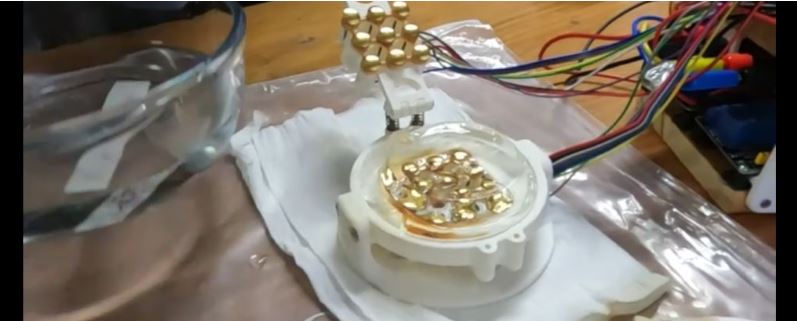


 11:52:20
11:52:20  2024-08-25
2024-08-25  969
969

A little blob of squishy transparent gel can not only play the video game Pong, it can get better at it over time.
When interfaced with an adapted version of the game via an electrode array, the simple polymer hydrogel displayed a measurable increase in accuracy, resulting in longer rallies. It's a finding that demonstrates the ability to remember, even in a very basic material.
The gel is, of course, very far from an artificial brain, but its newly discovered ability suggests some tantalizing new avenues for research and development.
"Our research shows that even very simple materials can exhibit complex, adaptive behaviors typically associated with living systems or sophisticated AI," explains biomedical engineer Yoshikatsu Hayashi of the University of Reading in the UK.
"This opens up exciting possibilities for developing new types of 'smart' materials that can learn and adapt to their environment."
The hydrogel in question is based on an electro-active polymer, or EAP. These are polymers that change their size or shape when an electric current is applied, and they're commonly used for actuators and sensors as a sort of artificial muscle.
Back in 2022, a team of researchers demonstrated that a glob of human brain cells in a dish can be taught to play Pong by giving it feedback that tells the glob whether it succeeded in hitting a simple pixel "ball" with a pixel "paddle".
Biomedical engineers Vincent Strong, William Holderbaum, and Hayashi, all at the University of Reading, wanted to explore whether a similar learning ability could be demonstrated in something far simpler than human brain tissue.
EAP hydrogel was the logical test subject. Ions – particles that have a charge – within the hydrogel's matrix of crosslinked polymer chains move when an electric current is applied, which causes the gel to change shape.
Previously, Hayashi and another team demonstrated how this phenomenon can be exploited to make hydrogel beat in sync with a pacemaker, like the way a heart beats, expanding and contracting.
They noticed in the course of this research that their polyacrylamide hydrogel retained a "memory" of the beating, even after the researchers stopped the pacemaker.
"The rate at which the hydrogel de-swells takes much longer than the time it takes for it to swell in the first place, meaning that the ions' next motion is influenced by its previous motion, which is sort of like memory occurring," Strong explains.
"The continued rearrangement of ions within the hydrogel is based off of previous rearrangements within the hydrogel, continuing back to when it was first made and had a homogeneous distribution of ions."
To push the hydrogel to the next step, the researchers developed a special interface and an adapted game of Pong, with just one paddle bouncing off the opposite wall of a digital court, like playing table tennis against a wall.
They used electrical stimulation to inform the gel of the randomized position of the ball, and measured the flow of ions to gauge the position of the paddle. They also observed how long each rally lasted – back-and-forth exchanges between the gel-controlled paddle and the wall, without missing – and found that the rallies got longer over time.
It took the gel around 20 minutes to reach its peak Pong skill level.
"Over time, as the ball moves, the gel gathers a memory of all motion. And then the paddle moves to accommodate that ball within the simulated environment," says Strong. "The ions move in a way that maps a memory of all motion over time, and this "memory" results in improved performance."
This memory, the researchers say, is evidence of an emergent ability, one that the material was not specifically designed or trained for. But that doesn't mean that the material is sentient, or behaving deliberately – just that the material has retained an impression of a physical influence, something that can be said of the skin on your cheek after laying on a crinkly pillow.
But the finding is still cool; it definitely opens some fascinating avenues for exploration. Not least of which is determining the mechanisms behind the memory, and whether it can be trained to perform other tasks.
"We've shown that memory is emergent within the hydrogels, but the next step is to see whether we can also show specifically that learning is occurring," Strong says.
Reality Of Islam |
|

For years,

New scienti

This is the

A computer
 9:3:43
9:3:43
 2018-11-05
2018-11-05
10 benefits of Marriage in Islam
 7:5:22
7:5:22
 2019-04-08
2019-04-08
benefits of reciting surat yunus, hud &
 9:45:7
9:45:7
 2018-12-24
2018-12-24
advantages & disadvantages of divorce
 11:35:12
11:35:12
 2018-06-10
2018-06-10
 6:0:51
6:0:51
 2018-10-16
2018-10-16
bahlool & the throne of haroun rashid
 8:20:35
8:20:35
 2018-06-21
2018-06-21
 8:4:21
8:4:21
 2022-01-08
2022-01-08
 7:26:19
7:26:19
 2022-04-08
2022-04-08
a hero waters thirsty wild animals
 9:4:9
9:4:9
 2022-01-06
2022-01-06
 2:5:14
2:5:14
 2023-01-28
2023-01-28
 7:0:55
7:0:55
 2022-05-17
2022-05-17
 7:59:14
7:59:14
 2018-06-21
2018-06-21
 5:41:46
5:41:46
 2023-03-18
2023-03-18
| LATEST |